Goa – Saturday 27 June – Friday 3 July 2009
On a long road trip like ours it's impossible to be everywhere at the right time season wise - and so far we've been pretty lucky managing to hit the quieter time of low season but without the bad weather.
Goa was the first place our luck didn't hold. More or less from the first day there we were pelted by the monsoons! As we are camping this was pretty tough going. The conditions were often typhoon-like with the result that everything got wet and having a shower was tough - the wind was so high the water blew away from us horizontally and once or twice we nearly lost the shower tent mid shower which would have been embarrassing!!


Still we did still see some positives in this most touristy state when the rain stopped. Palalem Beach is renowned for being one of the most beautiful in the state and it was lovely. We camped at the Palalem beach resort - or just outside it as we couldn't fit in the gate! - and they were very accommodating. Usually it is a Thomas Cook resort for package tours but we had it more or less to ourselves - other than the weekends when it filled up with Indian tourists.
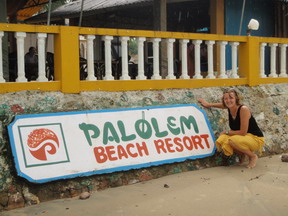

Goa has different tax laws and alcohol is extremely cheap. It is illegal to advertise alcohol in much of India but Goa seemed to be an exception with billboards everywhere. Thus at the weekends a lot of partying Indians turn up to drink and gawk at the bikini clad western women!!!! Allegedly coach trips with this objective in mind are organized - but this was all rained off when we were there so we can't comment! There seemed to be quite a few Indian families too, and some hardy European tourists.
We really noticed the sheer number of alcohol shops here - they are a bit hidden away in other parts of India but here every other shop seems to be a grog shop! Also immediately apparent was the huge Portuguese influence - the converters really got in here and the area is strongly catholic with few Hindus remaining.
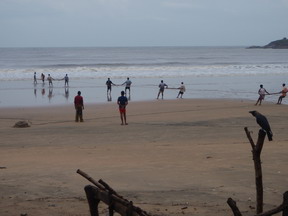

During the monsoon the fishermen aren't allowed out as it is too dangerous - though due to financial hardship some of them risk it. Instead every morning at Palolem beach we saw them walk the length of the beach with nets and bring in fish to divvy up for their own use. This is the only way they can fish during the monsoon months and on the day of our pictures they only got 6 baskets of fish. They told us this was incredibly poor - a good day would yield around 100 baskets. Obviously the monsoon season is also a low point for tourist related income so it can be time of real hardship here. For this reason we were warned to be particularly careful of our belongings due to theft, though I have to say we had no problems.
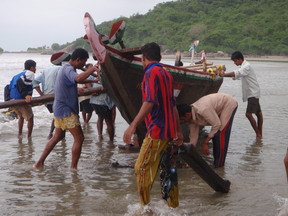
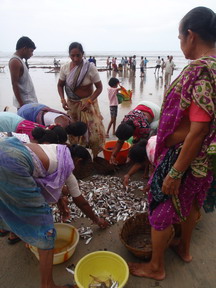
The main capital of Goa is Panaji which is a pleasant town full of old colonial buildings, and the usual Ghandi statue, though it was REALLY raining on the day we were there so we didn't look up much!

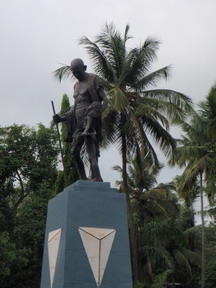
We enjoyed a nice lunch of a local (fish based) Thali. The food in Goa is very good and we tried some local specialties but not all! I had been keen to try the pork sausages until I saw the local village living arrangements by which the pigs live under the house and eat the waste from the open air loos- all very eco friendly - but makes it hard to fancy a plate of pork sausages!!! We also tried some of the local port - not too bad for $3 bottle - hic!!

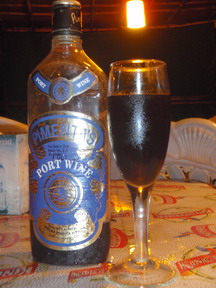
We spent a good (reasonably rain free) afternoon in old Goa. This was the original Goa, which was abandoned due to disease (malaria, typhoid you name it) hence there being both New and Old Goa. In its heyday supposedly it was a grand city comparable to Lisbon and signs of this can be seen in the magnificent churches. We saw the SE Cathedral a 16th century Portuguese gothic church, the Basilica of Bom Jesus and the Convent and Church of St Francis of Assisi. All of these are pretty impressive.


The Basilica of Bom Jesus houses the casket of Goas's patron saint - St Francis Xavier and what remains of his body. He was a Spanish missionary credited with spreading the Christian word to Goa. When he died in China whilst on another missionary quest, his servant (fearing he would have to send the body back to Goa) - put lime in to decompose it swiftly but despite this it refused to rot.
Thus the "incorruptible body of St Francis of Xavier" is seen as a Catholic miracle - officially recognized by the church when he was canonized in 1622. Various bit of him have been sent elsewhere - to missions throughout SE Asia. At some point a very overzealous (or mad!) pilgrim bit his toe off (euukkkk!!!!) and after this his corpse was kept in an ornate glass coffin out of view. Every ten years it is paraded around - the next viewing will be 2014 - but the corpse has by now given in to decay so the miracle is no more!
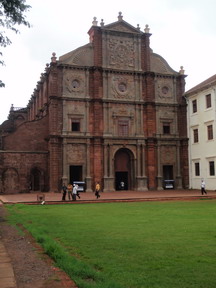

The 3 tiered marble tomb of St Francis the central point of the church is very impressive. Completed in 1698 it is encrusted with rubies and covered in gold and was all paid for by one Goan man- who must have felt sure of his place in heaven!!! However the actual body (or what remains of it!) is now placed to one side in a silver casket.
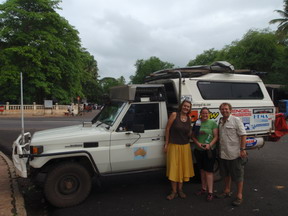
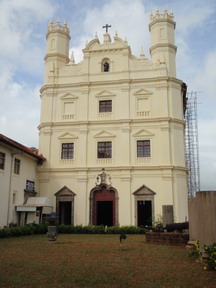
Old Goa was really interesting and very full of history. Whilst there we also managed to meet up with Jamilla from Australia. She is the great niece (or some such thing!) of our good friend Lorraine and we'd been talking to have via email so it was great to finally meet her. We hope to see her again in Nepal where she now heads to do some work for an orphanage.
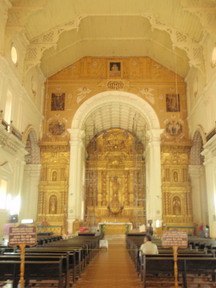
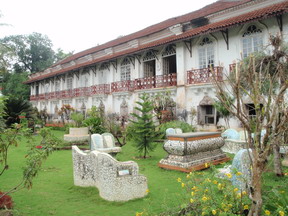
Next day we headed out to the small village of Chandor for yet more history. This was easier said than done as there were no signs but eventually - with a fair bit of help - we found it. Chandor a small village has a couple of superb colonial mansions. First we saw the Fernandes House - and were shown around by Rajeev Fernandes - whose family have owned this house since - forever! It is in fact the oldest house in Goa. Interesting the house had Hindu features though the family converted to Catholicism in the 16th century. They still retain their Hindu caste though and have on display artifacts relating to caste based rituals/dances. The Portuguese were very keen to convert the higher castes - thinking that they would have more authority and that others would follow, so they allowed that after conversion these distinctions would be retained. To us it seems a shame that the one good point about converting everyone - losing the unfair caste system - didn't happen! Rajeev's family are of the Kshatriya or warrior caste, 2nd only to the Brahmins.
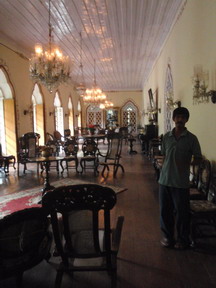
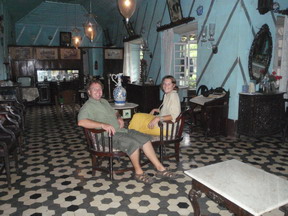
The house was really interesting and the family still live there though it must be very costly to maintain. It had chandeliers and love seats - very Portuguese. There was an interesting hidden tunnel - riddled with bullet holes - which lead out of the house to the river which was apparently used by the Hindu owners to escape from other Hindus during a localized war of some sort.
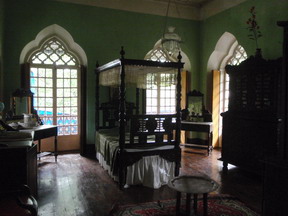
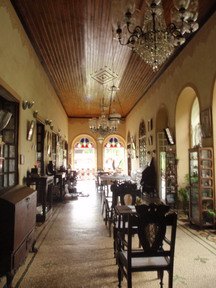
We then saw another larger mansion (the largest in Goa this time) the Braganza house - actually owned by the Fernandes' cousins. This was a 17th century pile which took up the entire length of the village square. Again this was full of interesting artifacts and again still used as a family home. The little boys in our pictures - who were playing up and refusing to do their homework! - are cousins and some of the 16th generation of the extended family who still live in the house - 16 people in all. It was really interesting to see these lovely old homes. They could probably use an injection of government cash to assist with keeping them maintained.
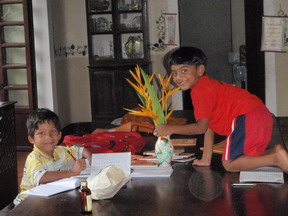

That night we managed to fill our water tank. This is often a challenge. In India they don't have water factories like in Thailand and we usually have to buy 20 litres drums of water and pour them in. On this occasion we asked a water tanker driver where to go and he offered to siphon us some water off. Andrew had to crawl around on the roof and we soaked the road as it surged out as the pressure was too high. Definitely another crowd puller!!!

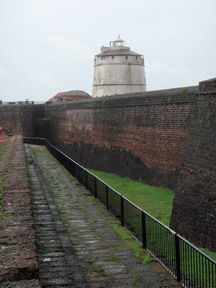
Next day we drove up the coast and had a look at Fort Aguada. Built by the Portuguese in 1612 this was a solid old structure. What surprised us though was the nearby gaol. We went to have a look thinking it would be a historical relic on display and found that despite the old grim stone structure, and old statues and signs it remains a working prison housing 120 prisoners!

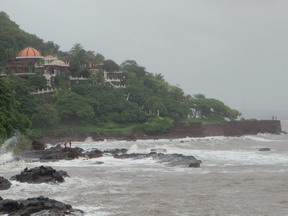
These prisoners share their view with the beautiful rich as this is also the site of some very upmarket resorts; we stopped off at the Aguada Heritage resort owned by the Taj group for a cup of tea. It was beautiful but even the very rich can't control the weather and a gale raged across the deck of the infinity edge pool !!

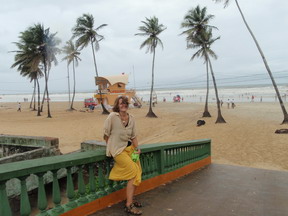
For our remaining time we camped one night at Benaulim beach - nice but very very wet - and then finally at Anjuna beach. This is "the" Goan beach, scene of the Wednesday markets and a big hippy hang out. It was scenic, though mostly shut down for the monsoon season and perched on a cliff we were more or less blown into the ocean so we didn't really see it at its best! We ate at a little beachfront café and met some nice people - but on the whole we were glad to leave wet windy Goa, and the next morning we drove through the rain on our way to our next destination Hampi.
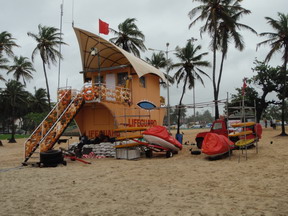

Again the road conditions can be pretty bad - we passed a few crazy accidents - things not helped by the addition of "Rumblers." These are little concrete speed bumps a good idea in theory but quite often there are no signs and they suddenly appear giving you no time to slow , in addition they are often in totally weird places nowhere near houses etc. They don't make for a comfortable ride!!!

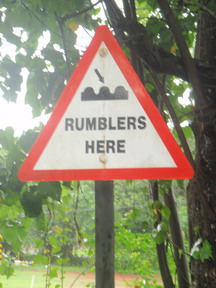
Hampi is back in the state of Karnataka so we had to once more cross the border. This turned out to be a bit of an experience. Due to the tax exemption thing in Goa we stopped at the border and filled up with petrol and bought a box of beer for the fridge. Everyone was doing likewise and the little border outpost was nothing but petrol pumps and grog shops. To get it cold we stacked it in the bottom of the fridge and piled our food baskets on top. Then we drove on.
As we reached the police check point 3 policemen came running over shouting "beer box where is beer box??" They started searching the car. This was the first time we heard that you aren't allowed to take alcohol over the border. There are no signs anywhere to tell you this and as I say the whole border was nothing but grog shops. We played dumb and it was hilarious. They had obviously had a tip off and knew it must be there but couldn't find it!! They opened the fridge but didn't look under the food. They were looking in the bed and crawling under the car! In the end we decided to tell them before they got really annoyed! We said that we'd just got a couple of bottles and showed them a couple from under the food baskets. They said we'd have to go back and get a certificate from the shop or we could pay them a "fine" - which if course was what it was all about! In the end we paid only about $2 Aus so the whole thing was hardly a major drama!
Finally on Friday 3 July still in the drizzle we left wet Goa and drove on towards the historical village of Hampi.
